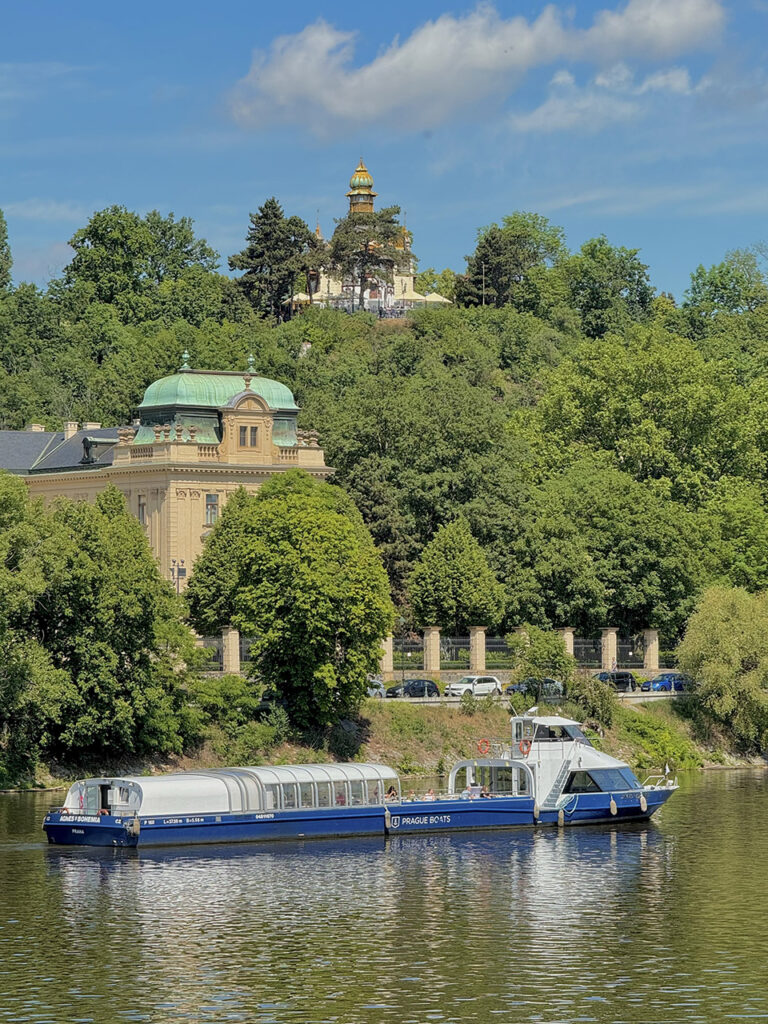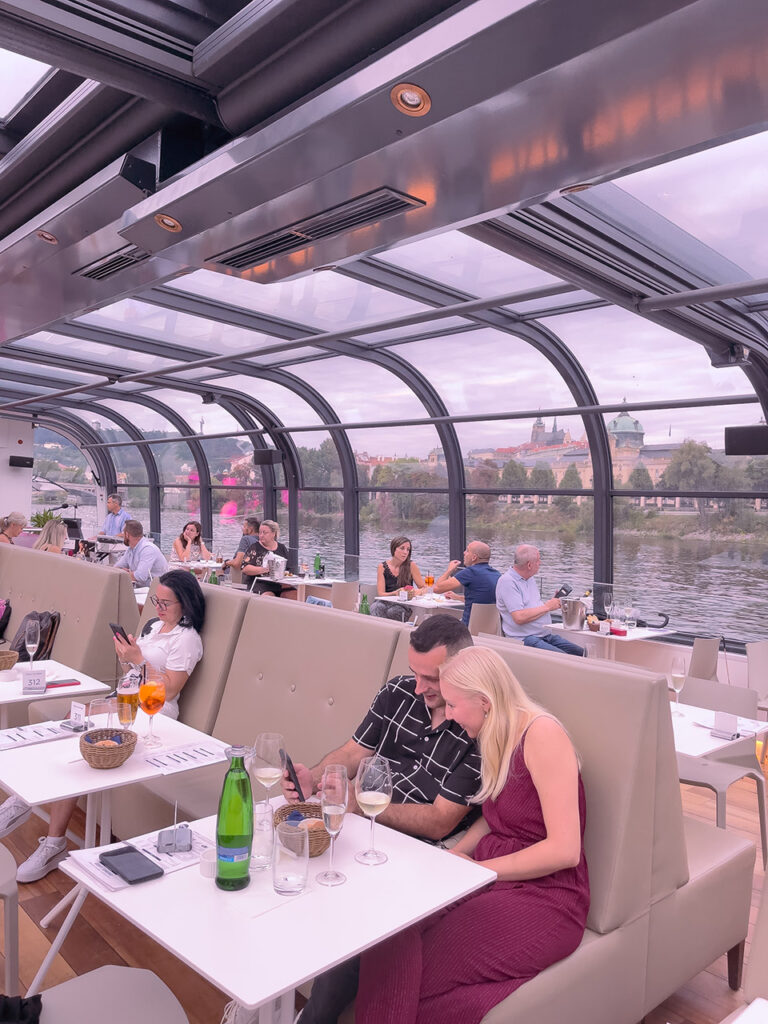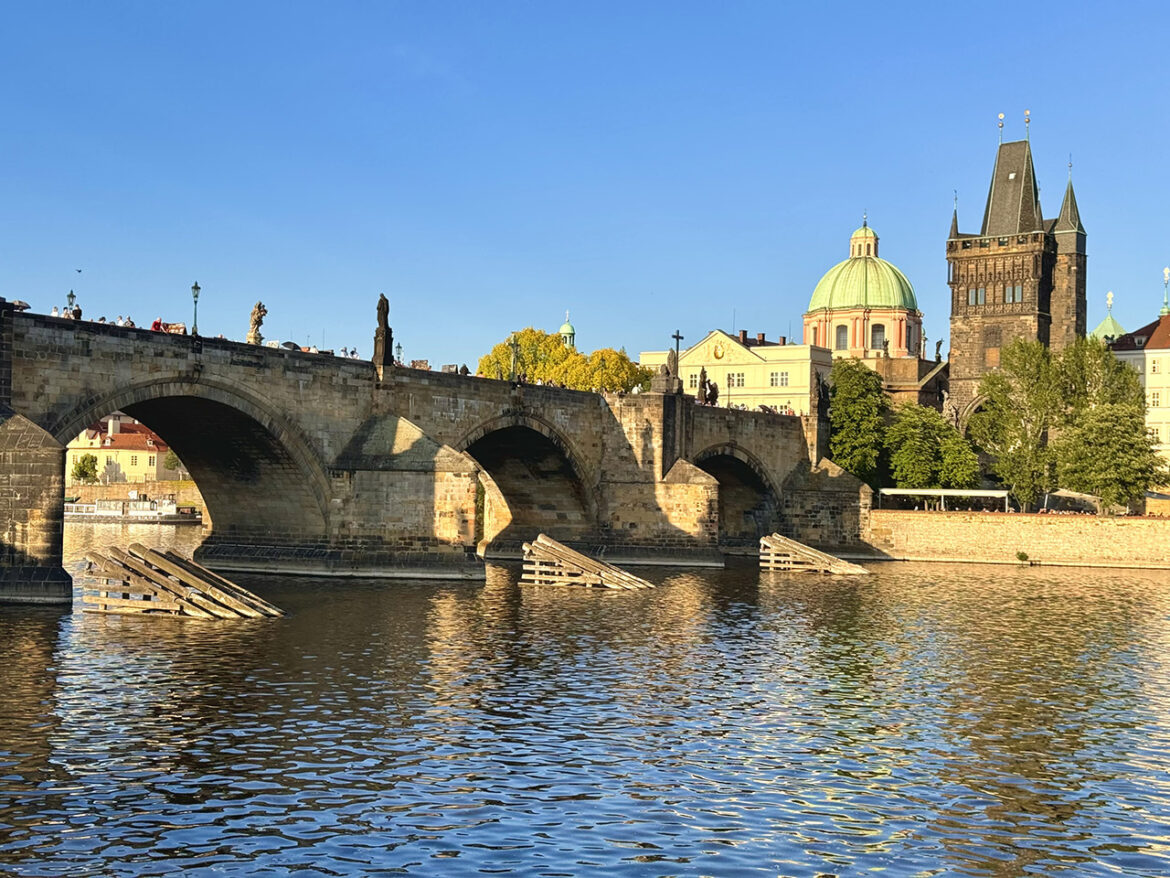One of the most popular ways to discover Prague’s history is on a sunset boat. Our evening sunset river tour on an open-top glass boat deluxe option included live music, an open buffet, and beverages! During the three-hour sightseeing cruise, you will enjoy stunning vistas from the open deck while enjoying a scrumptious open buffet, refreshing alcoholic or non-alcoholic beverages, and live music.
Glide around the Vltava River and spend a magical evening in Prague on a sleek open-top glass boat (https://www.prague-boats.cz/restaurant-cruises). On a dinner cruise along the Vltava River, begin your evening with a welcome sparkling Prosecco cocktail and a delicious buffet-style dinner on board while discovering Prague’s stunning illuminated castles and cathedrals. We chose the deluxe option, which included a bottle of alcoholic and non-alcoholic beverages, as well as a range of buffet items such as classic Czech Goulash with dumplings and hand-carved ham on the bone.

As the sun sets, Prague becomes even more splendid, especially as the lights illuminate the river. Dining under a glass dome roof offers panoramic views of Prague Castle, the National Theatre, and the underbelly of Charles Bridge as the boat passes beneath it. Beautiful live music set the tone for a romantic evening on the river.
Dinner buffet includes a diverse range of Czech and international dishes, including:
- Mozzarella with tomatoes and fresh basil pesto
- Selection of domestic cheeses, ham, and salami
- Duck pâté with cranberry sauce
- Gran Moravia cheese
- Greek salad
- Fresh coleslaw
- Chopped salad
- Selection of bread and butter
- Gluten-free pastries
- Chicken noodle soup
- Whole ham with bone
- Beef goulash
- Chicken schnitzels
- Baked potatoes with zucchini
- Spaghetti with cherry tomatoes and basil
- Paella
- Steamed vegetables
- Dumplings
- Jasmine rice
- Mashed potatoes
- Homemade desserts
- Fresh fruit salad
Find out more about Prague Boats’ 3-hour Crystal Dinner Cruise:
- Website: https://www.prague-boats.cz/crystal-dinner
- Instagram: https://www.instagram.com/prague_boats
Prague boats depart regularly from Pier 3B. You can purchase your ticket online in advance or at the office. (opening hours every day from 09:00 to 22:00)
Duration: 180 minutes. Entertainment: live music. Dining option: dinner buffet at Pier Čech Bridge.
Prices start at: Essential €69, Exclusive €89, DeLuxe €119, and children from €49.
How To Find?
Address
PRAGUE BOATS s.r.o.
Prague 1 – Josefov Dvořák Embankment (Dvořákovo nábřeží) Pier 3B
Our delightful evening in Prague on an upscale open-top glass boat included enjoying some of the city’s most important landmarks.







Cruise Guide:
- Municipal House: The structure was constructed in 1912 on the site of the previous Royal Court Palace, where the Old Town meets the New Town. In addition to being one of Europe’s greatest Art Nouveau buildings, it gained international recognition in 1918 when one of its halls hosted the momentous proclamation of Czechoslovakia’s independence.
- The Štvanice Island is located in the Holešovice bend of the Vltava River. The river used to be shallow, resulting in the formation of several islands. The islands progressively disappeared when the city began to regulate the river’s flow. Štvanice, known as “Great Venice,” was formerly a popular destination for entertainment, leisure, and culture. It now houses a well-known tennis centre and is slated for additional development as a sports facility.
- The Ministry of Industry and Trade Building is an impressive structure that stands out as a landmark along a tributary of the Vltava River. As we made our way to the wonderful Lod Pivovar (brewpub boat), we encountered this wonderful building. It is an office block, and the people employed there delight in the splendid views of Letna Park and the famous river.
- The St. Agnes Convent is one of Prague’s most important Gothic buildings. It was founded approximately 1230 AD by the Premyslid Princess St Agnes of Bohemia and her brother King Wenceslas I. The guided tour takes you through the history of each portion of the mediaeval monastery, which is unusually preserved. All significant areas are open to visitors, including the Oratory of St Agnes, the Shrine of the Saviour, and the Church of St Francis, which houses King Wenceslas I’s remains.
- The Adolf Loos Apartment and Gallery in the iconic EXPO 58 pavilion is located in Letenske Sady and offers views of Prague’s old and new towns, as well as the Vltava River. The structure includes a terrace with amazing views of Prague, which was erected above a remarkable renaissance wine cellar from the mid-16th century. Adolf Loos Apartment & Gallery presents a contemporary gallery and exhibition space for high-quality Czech and international art. The Expo 58 building is regarded as one of the most magnificent works of twentieth-century architecture, and it has come to symbolise Czechoslovak art and architecture’s international achievement.
- The St. Francis Hospital is located on the banks of the Vltava River. It is Prague’s oldest mediaeval centre, dating back 700 years. Bohuslav of Obramovice, a wealthy member of Prague’s Bourgeoisie, originally established it as a hospital for the impoverished who could not afford the services of doctors for medical care.
- The Prague Metronome: The enormous Metronome holds a historic place on the Prague map. A gigantic monument to Joseph Stalin stood right here, overlooking the city. It was dismantled with dynamite in 1962, several years after he died. The seven-ton Metronome, built in 1991, was intended to be a symbol of the new era. The surrounding area has become a skateboarder’s paradise.
- The Čech Bridge, located downstream along the river, is Prague’s tenth bridge. It is the only large Art Nouveau bridge in the country, hence it holds the status of a protected technical monument. It is the shortest bridge in Prague, being 16 metres wide and 169 metres long.
- Since the 19th century, the Občanská plovárna (Civic Swimming Pool) has been a summer entertainment destination for visitors to Prague. She has been reborn to continue serving the citizens and guests of this lovely city. The building itself, located on the banks of the Vltava River in the heart of the city, is a blend of ancient English architecture with the most innovative architectural principles available today. Offering panoramic views of Charles University, the Rudolfinum, and even the Charles Bridge. Obcanska Plovarna provides something for everyone, whether you’re spending the evening inside the club or on the expansive terrace outside.
- The Straka Academy: The public refers to this splendid neo-Baroque structure as the Straka Academy, which houses the Czech government and the Office of the Government. Following its completion in 1896, it operated as a student dormitory for destitute children of Czech noble families, as requested by Count Jan Petr Straka. Following WWII, it was confiscated for the Czechoslovak government’s use, and the Straka Academy has served as the Czech Republic’s government headquarters since 1993. The property also has an extensive garden.
- The Rudolfinum is Prague’s most prominent music venue and home to the Czech Philharmonic, which first performed here in 1896 under Antonín Dvořák. The Neo-Renaissance building was constructed from 1876 to 1884. Originally it housed a picture gallery, museum collections and a concert hall; from 1918 to 1938 and 1945 to 1946, it served as the National Assembly Building. The largest hall, Dvořák Hall, hosts extraordinary concerts of classical music.
- Prague Castle: The largest castle complex not just in the Czech Republic, but anywhere in the globe, contributes to Prague’s distinctive skyline. Wander through the castle courtyards, see the Old Royal Palace, tour the Cathedral of Saints Vitus, Wenceslas, and Adalbert, visit Saint George’s Basilica, and walk down the picturesque Golden Lane. We also recommend a stroll around the Royal Garden, where, in addition to its many enchanting nooks and corners, you will discover Renaissance masterpieces like as the Ball Games Hall and Queen Anne’s Summer Palace, commonly known as Belveder. Prague Castle, founded in the ninth century, became the residence of Bohemian monarchs and then Czech presidents, and has served as a symbol of the Czech state for over a millennium.
- Franz Kafka Museum (Herget Brickyard): The Herget Brickworks in the Lesser Town on the bank of the Vltava River houses a museum whose exhibitions provide insight into the life of Prague-born Franz Kafka (1883-1924), one of the most important figures in twentieth-century world literature. The exhibition includes most of Kafka’s first editions, correspondence, diaries, manuscripts, photographs, and drawings that have never been exhibited before.
- Lesser Quarter: Prague’s Lesser Quarter has an intriguing history. The area below Prague Castle and along the Vltava River was once a collection of minor towns outside the castle fortifications. At the time, the population was largely ethnic German, merchants invited by King Přemysl Otakar II. The town was wrecked by fire in a Hussite war in 1419, followed by another fire in 1541, which also damaged St. Vitus’ Cathedral.
- Charles Bridge: Prague’s oldest bridge was erected to replace the Judith Bridge, which was severely damaged by flooding in 1342. Construction of the new bridge, initially known as Stone Bridge or Prague Bridge, began in 1357 under the supervision of Charles IV and was completed in 1402. Since 1870, the bridge has been known as Charles Bridge. It is made of sandstone blocks and has defensive towers at both ends (Lesser Town Bridge Towers and Old Town Bridge Tower). From 1683 until 1928, 30 saint statues were carved to adorn the bridge, the most well-known being St John of Nepomuk.
- Kampa Island is a lovely and picturesque park located between the Vltava River and its side branch, Čertovka. Visitors can observe the massive mill wheel of the ancient Grand Priory Mill from the 15th century. Not unexpectedly, the respected travel website VirtualTourist named it the world’s second most beautiful city island. Picnics and relaxation are popular activities in the island’s grassy regions.
- The Old Town Weir was created in the 13th century to enhance the depth of the Vltava River, which was once extremely shallow. This enabled the deployment of a large number of water mills, which were frequently damaged by fire during wars, revolutions, and other calamities.
- The Kampa Museum in Prague is located in the former Sova’s Mills. It is a gallery that specialises in European art, including shows featuring works by Czech artists. The majority of the items in its collection are from the private collection of Meda Mládek, Jan V. Mládek’s wife. The museum is located on the shore of Kampa island, hence the name, with a massive chair sculpture built adjacent to the building is visible from a distance.
- Strahov Monastery: The Premonstratensian monastery was founded in 1140. The complex includes the church of the Assumption of the Blessed Virgin Mary, the rare Strahov Library with a number of mediaeval manuscripts, maps, and globes, the Baroque Theological Hall, the Classical Philosophy Hall with frescoes, and the Strahov Gallery. It is one of the most significant Central European collections of Gothic painting, Rudolfian art, and Baroque and Rococo paintings.
- National Theatre: The National Theatre is a historical opera house in Prague. It is regarded as the alma mater of Czech opera and a national landmark to Czech history and art.
- The Petřín Lookout Tower, a notable landmark in Prague, was built as part of the Jubilee Exhibition in 1891 as a rough duplicate of the Eiffel Tower (at a ratio of 1:5). It stands 58.70 metres tall and has 299 steps to its pinnacle, which is the same height as the original Eiffel Tower. On a clear day, the view from its peak encompasses practically all of Bohemia, not just the city.
- In 1996, the Dancing House, a modern architecture pillar in Prague, “danced” onto the Rašínovo Embankment. Vlado Milunić and Frank O. Gehry, world-renowned architects, designed the project. The concept was inspired by the legendary film couple’s dancing abilities: the stone tower represents Fred Astaire, and the glass tower represents his companion Ginger Rogers. The Dancing House features a museum and a café with a terrace that provides a 360° view of Prague.
- Staropramen Brewery (Pivovary Staropramen s.r.o.), located in Prague’s Smíchov area, is the Czech Republic’s second largest brewery. It began operations in 1869, and the brand name Staropramen, which translates as “old spring,” was registered in 1911. It is owned by Molson Coors and exports its goods to 37 countries, the majority of which are in Europe and North America.
- Emmaus Monestry: The Benedictine monastery Na Slovanech is distinguished by its unmistakable new white towers with golden spires from the 1960s. The original steeples were destroyed by fire during a 1945 bombing strike. Charles IV erected the church in 1347, and it became a centre for study, art, and Slavic literature. The cloisters contain the remains of rare Gothic wall paintings, while the Church of the Virgin Mary is painted in the Beuron style.
- Vyšehrad is the oldest residence of Czech princes, dating back to the mid-10th century. Situated on a rocky promontory above the Vltava River, it offers stunning views of the city. The park area contains hidden architectural treasures, such as the rare Romanesque Rotunda of St Martin. The neo-Gothic Church of Sts Peter and Paul, the national cemetery Slavn, and the underground casements housing some original Baroque statues from the Charles Bridge.
- The museum is located near the Podolí Waterworks Museum, a remarkable specimen of industrial architecture. The observation deck of the tower at a height of 40 metres provides an interesting view of the river and city. The permanent exhibition depicts the historical development of Prague’s first private water supply, beginning with the first private water mains in the 12th century and progressing through the Renaissance period Vltava waterworks and late nineteenth-century water supply building to the present.
- Vltava River: The Vltava River flows through the middle of Prague and is the waterway around which the city has evolved over the last several thousand years.


